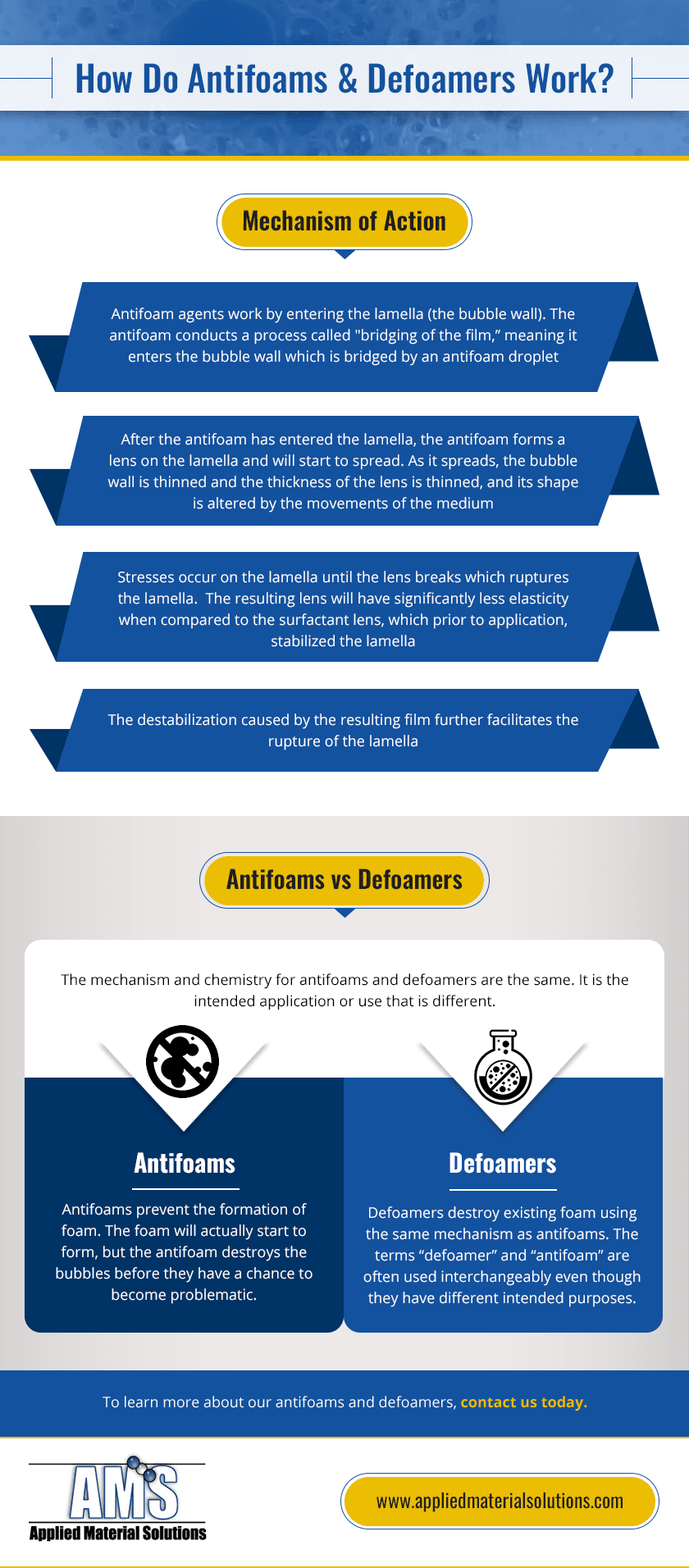Antifoam and defoamers are used to treat the build-up of foam in liquid solutions. While they have similar names, there is a difference between antifoam agents and defoamers. Antifoams are used to prevent foam from forming in the first place, whereas defoamers are used to control existing foam.
Applied Material Solutions and our predecessor companies have been providing antifoams and defoamers for over 45 years. We have an extensive product line, allowing us to provide the ideal foam control product for numerous industries. Our foam control products have a wide range of chemistries and have specialized formulas for different applications such as food-grade, tech-grade, and agriculture.
What is an Antifoam Agent?
True to its name, antifoaming agents are additives used to prevent the formation of foam. An antifoam agent refers to any additive that reduces the surface tension of the liquid foaming medium. As a result of reduced surface tension, the formation of foam and bubbles is reduced. Antifoam agents contain surface-active properties and are typically insoluble within the foaming medium. They tend to have a low viscosity, allowing them to easily coat the medium.
There are many antifoaming agents available on the market, with the most popular being constructed from various oils (like mineral oil), fatty alcohols (like stearyl alcohol), polydimethylsiloxanes (such as silicones), silicone surfactants, fatty acids, esters, ethers, and glycols.
What is a Defoamer?
Defoamers are made from liquid materials, with the most common forms being made from mineral oil or water as the continuous phase. These liquids are then paired with a hydrophobic solid, typically hydrophobic silica or a wax, such as fatty acids, ethylene-bis-stearamide, or fatty alcohols. Some of these hydrophobic solid ingredients are used individually, and other times defoamers will rely on multiple hydrophobic solids. In any case, an effective defoamer must be partly insoluble to the medium it is treating.
How Do Antifoams & Defoamers Work?
Antifoam agents work by entering the lamella (the bubble wall). The antifoam conducts a process called “bridging of the film,” meaning it enters the bubble wall which is bridged by an antifoam droplet. After the antifoam has entered the lamella, the antifoam forms a lens on the lamella and will start to spread. As it spreads, the bubble wall is thinned and the thickness of the lens is thinned, and its shape is altered by the movements of the medium. Stresses occur on the lamella until the lens breaks which ruptures the lamella. The resulting lens will have significantly less elasticity when compared to the surfactant lens, which prior to application, stabilized the lamella. The destabilization caused by the resulting film further facilitates the rupture of the lamella.
The mechanism and chemistry for antifoams and defoamers are the same. It is the intended application or use that is different. Antifoams prevent the formation of foam. The foam will actually start to form, but the antifoam destroys the bubble before it has a chance to be seen or have any effect. Defoamers destroy existing foam using the same mechanism as antifoams. The terms “defoamer” and “antifoam” are often used interchangeably even though they have different intended purposes.
Applications for Antifoams and Defoamers
- Food Processing and Agribusiness: For food processing, food-grade antifoams and defoamers must be used. These are typically water-based and contain silicone-based ingredients, but may also be based on various types of food-grade oils. Usually, kosher certification is a requirement.
- Water Treatment: Foaming and air entrapment are quite common in water treatment. Foam can slow down the treatment process, and can even block filtration systems.
- Paint, Inks, Coatings, & Adhesives (PICA): The mixing and grinding during the production of PICA products are the main causes of foam formation. Foam can negatively impact the production and use of these products.
- Chemical Manufacturing: Foam can create problems for just about any type of chemical manufacturing. Defoamers and antifoams are frequently used throughout the production process, including distillation, transfer, filtration, and synthesis. Defoamers and antifoams for chemical manufacturing can be designed to work in highly acidic or alkaline environments.
- Cleaning Compounds & Processes: Cleaning solutions can be negatively affected by too much foam. Using antifoams and defoamers is an effective way to stop inefficiencies caused by foam.
- Pulp & Paper: Recycle mills, sulfite mills, and kraft mills all rely on antifoams and defoamers. Foam buildup can lead to slower production rates, low-quality output, increased use of bleaching, inefficient washing, and maintenance problems.
- Oil and gas: Foam presents a significant risk to crude oil and gas production. In extreme cases, excessive foam can lead to production shutdowns. The oil and gas industry mostly relies on polymeric surfactant and silicone antifoams and defoamers to ensure product quality and smooth production.
- Mining: Modern mining and mineral processing relies on foam control to achieve peak efficiency. Like other industries, foam can cause problems in filtration and flotation systems.
- And more
The Chemistry Behind Antifoams and Defoamers
The Chemistry of Antifoams
Antifoams are generally inert chemicals. They often consist of a liquid component and a hydrophobic solid. The liquid components tend to be nonionic surfactants, mineral oils, or silicones. Common options for hydrophobic solids are waxes, fatty acids, fatty alcohols, or hydrophobic silica.
No matter which ingredients are used, they must be sufficiently incompatible to be insoluble with the foaming medium. Too much solubility will make it a poor option for effective foam mitigation. At the same time, they must be partly compatible to avoid deposition issues.
Antifoams are often grouped into major categories, such as silicone or non-silicone, or water-based or oil-based, etc. Silicone antifoams are normally made from hydrophobized silica which is dispersed within silicone fluid. The resultant compound is then typically stabilized into a water-based emulsion. Silicone antifoams are incredibly effective and potent at very low concentrations. They can be easily combined with other active ingredients to enhance their defoaming properties.
Non-silicone antifoams usually rely on surfactants, but can also be water-based or oil-based. Non-silicone antifoams tend to be more biodegradable. Additionally, they are less likely to cause discoloration, negative membrane effects, or spotting.
The Chemistry of Defoamers
Defoamers are very similar in chemical makeup and properties to antifoams. Both are often made with a liquid and hydrophobic solid, although some defoamers can be strictly liquid. Much like antifoams, defoamers must have a proper balance between solubility and insolubility.
The actual chemical makeup can be very wide-ranging and sometimes extremely complex. Then again, some defoamers are as simple as just a single liquid component. Among other ingredients, they can contain silicones, alkoxylated polymers, esters, hydrophobic solids, and more. Some offer high efficacy rates at low dosages when rapid foam knockdown is needed.
Some Benefits of Antifoams and Defoamers
Antifoams and defoamers are used across a wide range of industries for a variety of reasons, not the least of which is improved profitability and cost savings.
A wastewater treatment plant may use a defoamer to maximize efficiency, whereas a food processing plant may use antifoams to prevent the splashing of hot cooking oils. Foams can also create slip hazards, which makes defoamers and antifoams valuable tools in keeping workplaces safe. At their core, they are an effective means to quickly release entrapped gases.
Regardless of the application, both antifoams and defoamers come in a wide range of chemical makeups to better suit individual industries and applications. Antifoams and defoamers can be specifically designed to improve biodegradability and reduce bioaccumulation. They can also be altered when strict environmental regulations are in place.
Antifoam and Defoamers From AMS
No matter what type of defoamer or antifoam you need, AMS can help you find the right solution. We carry a wide range of both antifoams and defoamers.
Antifoam Options:
- Silicone antifoams
- Water-based antifoam emulsions
- Non-aqueous silicone antifoam compounds
- Specialty silicone antifoams
- Non-silicone antifoams
- Surfactant-based antifoams
- And more
Defoamer Options:
- Powdered defoamers
- Food-grade defoamers
- Tech-grade defoamers
- Oil-based defoamers
- Polymer-based defoamers
- Ester-based defoamers
- Vegetable oil-based defoamers
- And more
If you have any questions about our antifoam or defoam products, feel free to contact us at any time.



